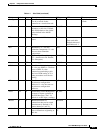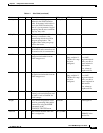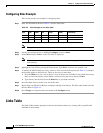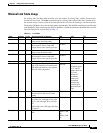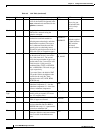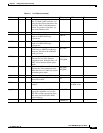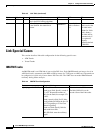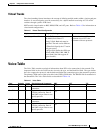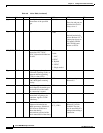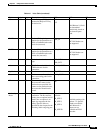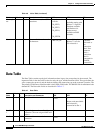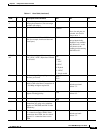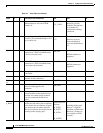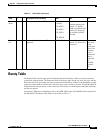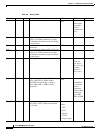
4-11
Cisco WAN Modeling Tools Guide
OL-10426-01, Rev. A0
Chapter 4 Configuration Tables and Fields
Voice Table
Virtual Trunks
The virtual trunking feature introduces the concept of defining multiple trunks within a single trunk port
interface. It was developed to provide connectivity for a hybrid network consisting of Cisco ATM
switches through a public ATM cloud.
NMT models virtual trunks on BNI, BXM, BTM, and AIT ports. Refer to Table 4-5 for information on
virtual trunk configurations.
Voice Table
The Voice Table contains topological information about IGX voice connections in the network. The
important fields in the voice table are the site ends, the type, and the BackCard field. The type defines
the voice compression protocol, and the backcard defines the connection type at the customer's premise.
The primary CWM source of the voice table is the USER_CONN table. The WANDL file for translation is
the demand file. The Voice Table fields are described in Table 4-6.
Table 4-5 Virtual Trunk Configuration
Topic Required Settings Comments
Specifying a Virtual Trunk Links Table
M (Media) field: Enter VT
Trnk_Cd field: Both ends must be
specified. The ends can be different.
VTRate field: Specify the VT rate in
cells per second.
...&Type field: Define the ATM type
of link (ABR, CBR, UBR, VBR, or
leave blank if the links support all
types of traffic).
If the back cards are different, the
maximum size of VT is the
minimum of the two protocols.
Table 4-6 Voice Table
Field Defaults Notes Description and Comments DBF CET TPI
Site 1 – M/H Site name of owner of a
connection.
SITE1 * *
Port ID 1 0 O Logical slot/port number at Site
1 for the connection. Enter 0
and NMT assigns. Enter n.m to
specify port.slot.
ID1 *
Site 2 – M/H Site name of remote end of a
connection.
SITE2 * *
Port ID 2 0 O Logical slot/port number at Site
2 for the connection. Enter 0
and NMT assigns. Enter n.m to
specify port.slot.
ID2 *



